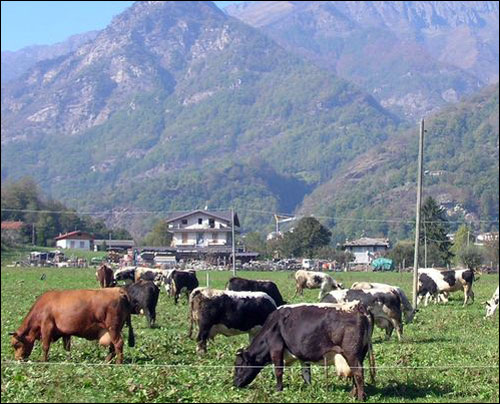After an initial two-year pilot designed to track the production and shipment of cheese, the Turin Chamber of Commerce, in Italy, has begun planning a wide deployment of RFID and bar-code technologies that would ultimately allow consumers to view the history of the cheese, as well as the milk from which it was produced. The initiative is one of many carried out by the chamber to fulfill its mission of fostering economic growth in the province of Turin.
During the pilot, dairy farmers placed passive high-frequency (HF) RFID tags on individual wheels of cheese and used handheld readers to interrogate the tags, with each tag’s ID number linked to information stored on a Web-based server. In 2011, when deployment of the project’s next phase is expected to take place, merchants will be able to use handheld readers to record the cheese’s arrival at their store, as well as the date that the product was placed in the front of the store for purchase. Customers would then bring the cheese to an RFID-enabled kiosk to learn details about the product before buying it. The system would enable a store to better manage its cheese inventory, and farmers will be able to view a history of cow productivity at their farms by accessing data regarding each cow’s milk yields, as well as the cheese made from that milk. The priority, however, is to link a wheel of cheese in the store with that product’s first origins—the grass consumed by grazing cows whose milk is the cheese’s main ingredient.

The project participants included the University of Turin, which researched the quality of the grass and milk, and the Turin Chamber of Commerce Chemical Laboratory. Hardware company Logical Tag Technologies (LTT) provided tags and readers that were used by two local farms, Gonnet Sabina and Aglì Marco, which owned the cattle and created the cheese. Software to interpret and store information from RFID tag reads, as well as a hosted server to store data about the milk and cheese was provided by 3a. The project was managed the Chamber of Commerce as well as the Torino Wireless Foundation, an organization supports regional technological research and development.
The goal of the cheese-tracking project is to enhance the value of the area’s products, by providing consumers with visibility into the product’s origins, as well as introducing supply-chain traceability to ensure that the product is delivered to retailers and to eliminate counterfeit cheeses. Counterfeiting of high-quality cheese is an ongoing problem in Italy since Alpine cheeses cost 30 to 100 percent more than similar products. Toma cheese, produced by the region’s small Alpine farms, is scarce and highly valued; the cheese’s quality makes it a high-end product that consumers pay more for than they would for other cheeses. To provide customers with a view into the cheese’s quality prior to purchase, the Turin Chamber of Commerce conceived of a wireless solution that would capture and store data not only about where and when the cheese was made, but also the type of grass eaten by the cow that produced the cheese’s milk.
Thus, in 2008, the chamber of commerce launched what it called the Trace Cheese project, and employed Torino Wireless to deploy and manage a trial of a system in which dairy farmers, Toma cheese producers, retailers and consumers could all access information about the product on a server. The first year of the pilot involved planning, while the RFID hardware was piloted in the second season of cheese production.
The University of Turin’s forestry department, which focuses on agronomy and grazing land management, provided the research services regarding the type and nutritional content of grass found in specific grazing areas. University researchers divided grazing areas into multiple geographic zones on each of the two farms, and took samples of grass from each zone. The researchers determined the types of grass in each sample, and analyzed its nutritional content. That information was input into the university’s software system and stored on the Trace Cheese server, and each of the 50 cows involved in the project were then assigned to a specific zone for grazing.
After the cattle were milked (a cow produces approximately 6 to 10 liters daily), a bulk milk yield was stored in the database. Samples of the milk were tested by scientists at the chemical lab operated by the Turin Chamber of Commerce, and data regarding the milk was also entered into the Trace Cheese server. The two farms then proceeded to make Toma cheese. The cheese was molded into 8-inch-wide wheels (it takes approximately 60 liters of milk to make a single wheel, which weighs approximately 13 pounds). Once the cheese had ripened, requiring several months of aging, each wheel forms a natural rind, and a paper label is attached to the rind on the back of each wheel. The farms then attached a passive 13.56 MHz RFID tag, compliant with the ISO 15693 standard, to the paper label.
Staff members employed an LTT handheld RFID reader to capture the unique ID number encoded to each wheel’s tag, and linked that ID to data throughout the food chain—from the type and nutritional content of grass grazed to shipment of cheese to the store. Researchers selected only a few wheels of Toma cheese for tagging—from about four grazing zones . As the wheels were shipped to nearby stores, their tags were again read with the handheld interrogator, and workers updated each wheels’ status to indicate it was being shipped, and to what location. Using a cellular connection, the handhelds transmitted data to the Trace Cheese server, on which software provided by 3a linked data related to the RFID reads—the date, the time and a unique ID number—with details about the product, and made it available for pilot participants to view. The participating farmers and researchers could then use a password to log onto the server via the Internet in order to access that information. In the future, the data will also be available to retailers and customers.
Although the pilot did not include tracking the cheese as it arrived at a store, the group intends to do so in 2011, as part of a larger deployment. In that case, when a wheel of Toma cheese arrives at a store, employees would utilize a handheld interrogator to read its tag’s ID number. This tag-read data would be stored in the Trace Cheese server, to indicate the date and time of the product’s receipt. The store management could then use that information to track its own cheese inventory and determine whether a shipment has arrived, or when the store may need to reorder, by comparing sales data with incoming RFID reads. Producers could also use the data to manage their own inventory by tracking the number of wheels that had been shipped.
In 2011, consumers at participating stores in Italy will be able to take a wheel of Toma cheese to a kiosk, where a built-in RFID reader will read the cheese’s tag (the kiosk will also be able to scan a 2-D bar-code printed on that tag). If a customer has a mobile phone, he or she will be able to use it to photograph a bar code and upload the image to the Trace Cheese Web site, where that individual could then view details about the cheese and the origins of its milk, as well as the product’s nutritional content, such as the quantity of monounsaturated and polyunsaturated fats. In addition, an RFID-enabled kiosk will be installed next year at EatalyNY, to showcase the technology for New York consumers.
The research group had initially hoped to attach the tag directly to the cheese, thereby ensuring that it would not be removed prior to sale. However, the concept of placing the tag directly onto the cheese’s rind surface raised concerns regarding potential food contamination, according to Pasquale Marasco, a senior business analyst with the Torino Wireless Foundation’s business acceleration department. Ultimately, he says, the group opted to attach the tag, via adhesive, to the paper label attached to the wheel of cheese at the end of its ripening phase.
“We have demonstrated with this pilot that the tags—and, in general, the technology—can be applied in the agrifood sector,” Marasco states. By further deploying the technology into stores, he says, researchers and the Turin Chamber of Commerce hope to “authenticate the product and promote it in strong relation with the land.” How and when it will be deployed will be decided in 2011, he says, as pilot participants review the results.
In 2007, Torino Wireless, in collaboration with the chamber of commerce, also tested RFID technology to track wine bottles. The system was tested at three Piedmont winemakers, to track a limited number of bottles using 3a software and LTT passive tags and readers. The goal, Marasco says, was to determine whether passive 13.56 MHz RFID tags could be read in a supply chain environment—and the results, he reports, were favorable. The researchers may also discuss further wine-tracking pilots or deployments next year.


